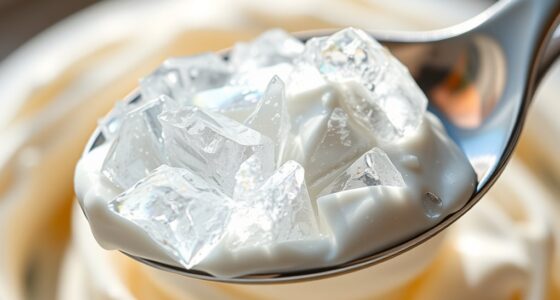Soft serve and hard pack ice creams differ mainly in their composition; soft serve contains 25% to 50% air, giving it a light, creamy, and airy texture, while hard pack is denser with less air, resulting in a firmer, more concentrated flavor. Soft serve is brewed at higher temperatures to stay soft and melt quickly, whereas hard pack is stored colder for longer shelf life. If you want to explore more about these differences, you’ll find some interesting details ahead.
Key Takeaways
- Soft serve contains 25%-50% air (overrun), making it lighter and creamier, while hard pack has less air, resulting in higher density.
- Soft serve is produced and served at higher temperatures (-4°C to -6°C), maintaining a soft, airy texture; hard pack is stored at around -20°C for firmness.
- Hard pack’s lower air content concentrates flavors more intensely than the more delicate flavor profile of soft serve.
- The higher air volume in soft serve enhances its velvety, melt-in-the-mouth texture, unlike the denser, more substantial hard pack.
- Hard pack’s density allows for longer storage without losing firmness, whereas soft serve is meant for immediate consumption.

When choosing between soft serve and hard pack ice cream, understanding their differences can help you make a better decision. One of the main distinctions lies in their composition, which directly impacts ice cream texture and flavor consistency. Soft serve ice cream is made with a higher air content—often between 25% to 50%—giving it a light, airy feel. This added air, known as overrun, makes the ice cream smoother and creamier, but also less dense. As a result, soft serve tends to have a delicate, velvety texture that melts quickly in your mouth. Its texture is easy to scoop and serve, which is why you typically find it in cones or cups at ice cream shops. Because soft serve is produced and dispensed at a higher temperature—around -4°C to -6°C—it remains soft and easy to serve, maintaining a fluffy, almost whipped consistency that’s appealing and inviting. Additionally, soft serve is often more customizable with mix-ins and flavor swirls, enhancing its versatility.
In contrast, hard pack ice cream is churned at lower temperatures, usually around -20°C, which results in a denser, firmer product. During production, less air is incorporated, leading to a richer, more substantial texture. When you bite into hard pack ice cream, you’ll notice a firmer, more solid consistency that holds its shape well. This density enhances flavor delivery because the ice cream’s ingredients—milk, cream, sugar, and flavorings—are more tightly packed, providing a consistent flavor experience with every spoonful. The flavor consistency in hard pack is generally more pronounced and intense because the lower air volume allows the true taste of the ingredients to shine through. This makes hard pack ice cream ideal for those who prefer a more substantial, flavorful treat that’s less airy and more satisfying.
Furthermore, the compositional differences influence storage and serving. Soft serve is meant to be served immediately after production, maintaining its soft texture, while hard pack ice cream can be stored for longer periods without losing its firmness. If you value a rich, dense scoop with a strong flavor punch, hard pack is the way to go. But if you prefer something light, fluffy, and quick to melt, soft serve will satisfy that craving. Knowing these compositional differences helps you choose based on your texture and flavor preferences, ensuring you get the ice cream experience you’re craving.
Frequently Asked Questions
How Does Storage Temperature Affect Ice Cream Consistency?
You’ll notice that storage temperature greatly impacts ice cream consistency. When you keep it too warm, larger ice crystals form, making it gritty and less smooth. Conversely, lower temperatures prevent excessive ice crystal formation, ensuring a creamy texture. Maintaining the right storage temperature keeps your ice cream’s consistency ideal, whether soft serve or hard pack, by controlling ice crystal formation and preserving its quality.
What Are the Best Flavor Options for Soft Serve Versus Hard Pack?
Think of soft serve as a blank canvas, ready to showcase a rainbow of flavors, from fruity sorbets to rich chocolates, thanks to its flavor versatility and ingredient variety. Hard pack, on the other hand, shines with classic favorites like vanilla, chocolate, and mint that hold their form. Whether you crave the playful swirl of soft serve or the timeless charm of hard pack, both offer delicious options tailored to your taste buds.
How Does Air Incorporation Differ Between Soft Serve and Hard Pack?
You’ll notice air incorporation differs markedly between soft serve and hard pack. Soft serve has more air bubble formation, which creates a lighter, creamier texture and greater texture variation. Hard pack contains less air, making it denser and firmer. This difference influences mouthfeel and flavor release, with soft serve feeling fluffier and easier to scoop, while hard pack offers a more substantial, intense flavor experience due to its lower air content.
Which Type Has a Longer Shelf Life?
Ironically, soft serve’s fleeting freshness makes you think it has a longer shelf life, but hard pack actually wins. You’ll find that its lower air content and advanced preservation techniques give it better shelf stability. Hard pack benefits from refrigeration, maintaining quality longer, while soft serve’s high air incorporation and delicate structure make it more perishable. So, if longevity’s your goal, hard pack’s your best bet.
Can Soft Serve Ice Cream Be Made With Dairy-Free Ingredients?
Yes, you can make soft serve ice cream with dairy-free ingredients. You just need to use dairy-free alternatives like coconut milk, almond milk, or cashew cream, combined with plant-based ingredients to achieve the right texture and flavor. Many commercial and homemade recipes incorporate these options, making soft serve accessible for vegans or those with dairy allergies. With the right ingredients, you can enjoy smooth, creamy dairy-free soft serve anytime.
Conclusion
Ultimately, choosing between soft serve and hard pack is like selecting a season—each offers its own flavor of satisfaction. Soft serve, with its fleeting, airy charm, symbolizes youth and spontaneity. Hard pack, with its rich, lasting presence, embodies tradition and depth. Both serve as reflections of your mood and moment. In the end, it’s not just about the ice cream, but about embracing the unique sweetness each one brings to your life’s tapestry.










